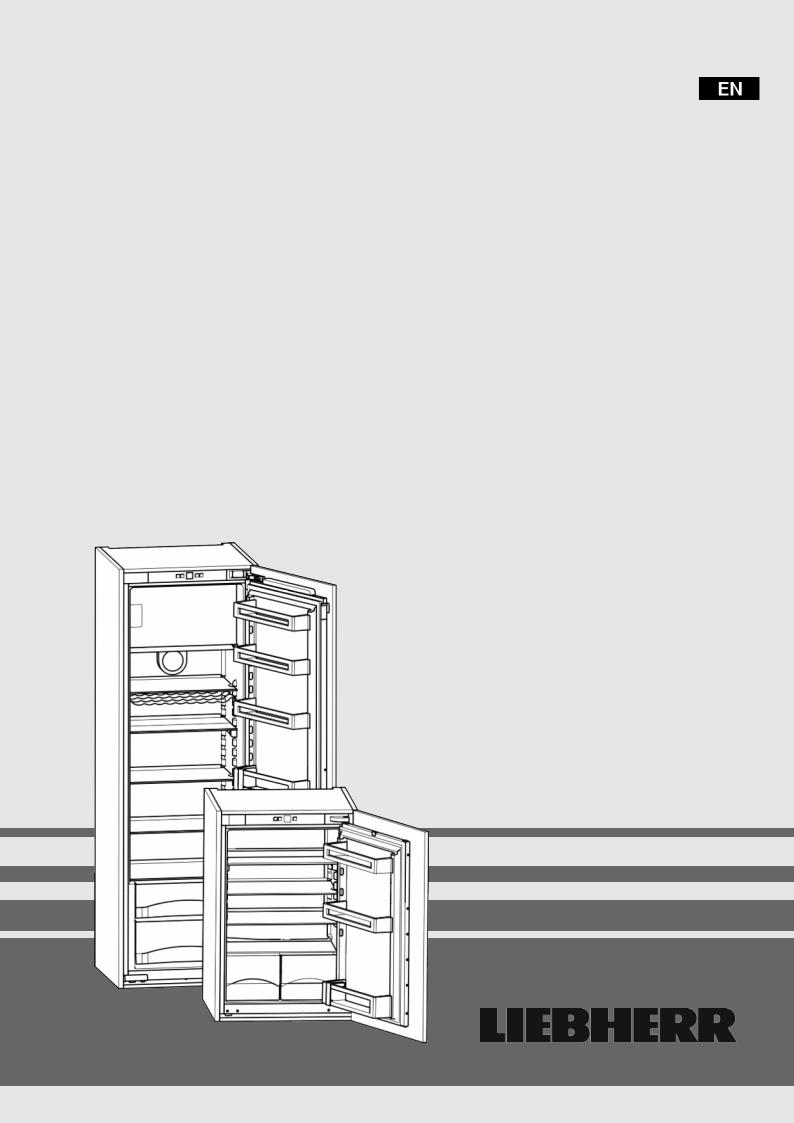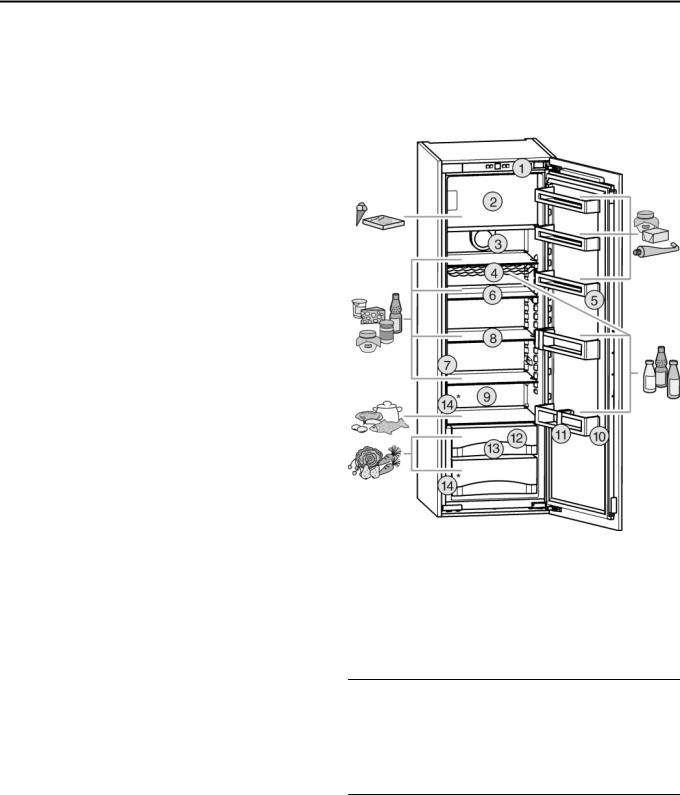Liebherr IK 3520-20, IKP 1960-61, IK 1620-20, IKS 1620, IKS 2330 User manual
...
Operating instructions
Built-in refrigerators
010217 7086508 - 00
IK(P)/ IKS/ EK ... LC

Appliance at a glance
Contents |
|
|
1 |
Appliance at a glance............................................ |
2 |
1.1 |
Description of appliance and equipment.................. |
2 |
1.2 |
Appliance range of use............................................. |
2 |
1.3 |
Conformity................................................................ |
3 |
1.4 |
Saving energy.......................................................... |
3 |
2 |
General safety information................................... |
3 |
3 |
Controls and displays........................................... |
4 |
3.1 |
Operating and control elements............................... |
4 |
3.2 |
Temperature display................................................. |
4 |
4 |
Putting into operation............................................ |
5 |
4.1 |
Switching on the appliance....................................... |
5 |
5 |
Control.................................................................... |
5 |
5.1 |
Child proofing........................................................... |
5 |
5.2 |
Refrigerator compartment........................................ |
5 |
5.3 |
Freezer compartment............................................... |
7 |
6 |
Maintenance........................................................... |
8 |
6.1 |
Defrosting................................................................. |
8 |
6.2 |
Cleaning the appliance............................................. |
8 |
6.3 |
Customer service..................................................... |
9 |
7 |
Malfunctions........................................................... |
9 |
8 |
Decommissioning.................................................. |
10 |
8.1 |
Switching off the appliance....................................... |
10 |
8.2 |
Taking the appliance out of service........................... |
10 |
9 |
Disposing of the appliance................................... |
10 |
The manufacturer works constantly on the further development of all the types and models. Therefore please understand that we have to reserve the right to make design, equipment and technical modifications.
To get to know all the benefits of your new appliance, please read the information contained in these instructions carefully.
The instructions apply to several models. Differences may occur. Text relating only to specific appliances is marked with an asterisk (*).
Instructions for action are marked with a  , the results of action are marked with a
, the results of action are marked with a  .
.
1 Appliance at a glance
1.1 Description of appliance and equipment
Fig. 1 |
(9) Coldest zone ** |
|
(1) |
Operating and control |
|
(2) |
elements |
(10) Bottle rack |
Freezer compartment* |
||
(3) |
Fan* |
(11) Bottle holder* |
(4) |
Bottle shelf* |
(12) BioCool* |
(5) |
Can rack |
(12) Vegetable compartment* |
(6) |
Shelf, sectioned* |
(13) Drain hole |
(7) |
LED interior light |
(14) Type plate |
(8) |
Shelf |
|
Note
u Sort foodstuffs as shown in the illustration. This enables the appliance to work in an energy-saving manner.
u Trays, retractable shelves or baskets are arranged ex-factory with optimum energy efficiency in mind.
u ** On appliances with a freezer compartment, the coldest zone is located beneath the freezer compartment whenever the fan is running.
1.2 Appliance range of use
Intended use
The appliance is only suitable for cooling food products in a domestic or household-like environment. This includes, for example, use:
-in staff kitchens, bed and breakfast establishments,
-by guests in country houses, hotels, motels and other accommodation,
2 |
* Depending on model and options |

General safety information
-for catering and similar services in the wholesale trade.
All other types of use are not permitted.
Foreseeable misuse
The following applications are expressly forbidden:
-Storing and refrigerating medicines, blood plasma, laboratory preparations or similar substances and products based on the Medical Device Directive 2007/47/EC
-Use in areas at risk of explosions
Misusing the appliance may lead to damage to the goods stored or they may spoil.
Climate classifications
Depending on the climate classification the appliance is designed to operate in restricted ambient temperatures. The climate classification applying to your appliance is printed on the rating plate.
Note
uKeep to the specified ambient temperatures in order to guarantee that the appliance works properly.
Climate clas- |
for ambient temperatures of |
sification |
|
SN |
10 °C to 32 °C |
N |
16 °C to 32 °C |
ST |
16 °C to 38 °C |
T |
16 °C to 43 °C |
1.3 Conformity
The refrigerant circuit has been tested for leaks. In installed condition, this appliance complies with the applicable safety stipulations and with directives 2014/35/EU, 2014/30/EU, 2009/125/EG, 2011/65/EU and 2010/30/EU.
1.4Saving energy
-Pay attention to good ventilation. Do not cover ventilation holes or grids.
-Always keep the fan air slits clear.*
-Do not install the appliance in direct sunlight, next to an oven, radiator or similar.
-Energy consumption is dependent on the installation conditions, e.g. ambient temperature (see 1.2) . If the ambient temperature deviates from the standard temperature of 25°C, the energy consumption may differ.
-Open the appliance for as short a time as possible.
-The lower the temperature is set the higher the energy consumption.
-Arrange the food in an organised way (see Appliance at a glance).
-Keep all food properly packed and covered. This prevents frost from forming.
-Only take food out for as long as necessary so that it doesn’t warm up too much.
-first.Inserting warm food: allow to cool down to room temperature
-Thaw frozen food in the refrigerator.*
-If there is a thick layer of frost in the appliance: defrost the appliance.*
2 General safety information
Danger for the user:
-This device can be used by children and people with impaired physical, sensory or mental abilities or with a lack of experience and knowledge provided that they are supervised or have received instruction in the safe use of this device, and about the resulting hazards. Children must not play with this appliance. Cleaning and user maintenance work must not be carried out by children without adult supervision. Children aged between 3 and 8 are allowed to load and unload the appliance. Children below the age of 3 must be kept away from the appliance unless they are under continuous adult supervision.
-When disconnecting the appliance from the supply, always take hold of the plug. Do not pull the cable.
-In the event of a fault pull out the mains plug or deactivate the fuse.
-Do not damage the mains power cable. Do not operate the appliance with a defective mains power cable.
-Have any repairs to or intervention in the appliance, and any change of the mains power cable, carried out by the customer service only or by other specialised personnel trained for the purpose.
-Only install, connect and dispose of the appliance according to the instructions.
-Only use the appliance when it is installed.
-Please keep these instructions in a safe place and pass them on to any subsequent owners.
-Special-purpose lamps (incandescent lamps, LEDs, fluorescent tubes) in the appliance serve to illuminate the appliance interior and are not suited for room illumination.
Fire hazard:
-Refrigerant R 600a is environmentally friendly, but flammable. Leaking refrigerant may ignite.
•Do not damage the refrigerant circuit pipes.
•Do not use an open flame or other source of ignition inside the appliance.
•Do not use electrical appliances inside the appliance (e.g. steam cleaners, heaters, ice cream makers, etc.).
•If the refrigerant leaks: remove any naked flames or ignition sources from the vicinity
* Depending on model and options |
3 |

Controls and displays
of the leakage point. Properly air the room. Inform customer services.
- Do not store explosives or sprays using combustible propellants such as butane, propane, pentane, etc. in the appliance. To identify these spray cans, look for the list of contents printed on the can, or a flame symbol. Gases possibly escaping may ignite due to electrical components.
- Please be sure to store alcoholic drinks or other packaging containing alcohol in tightly closed containers. Any alcohol that leaks out may be ignited by electrical components.
Danger of tipping and falling:
-Do not misuse the plinth, drawers, doors etc. as a step or for support. This applies particularly to children.
Danger of food poisoning:
-Do not consume food which has been stored too long.
Danger of frostbite, numbness and pain:
-Avoid lasting skin contact with cold surfaces or refrigerated/frozen food or take protective steps, e.g. wear gloves. Do not consume ice cream, water ice or ice cubes immediately and do not consume them too cold.
Danger of injury and damage:
-Hot steam can lead to injury. Do not use electrical heating or steam cleaning equipment, open flames or defrosting sprays to defrost.
-Do not use sharp implements to remove the ice.
Danger of crushing:
-Do not hold the hinge when opening and closing the door. Fingers may get caught.
Symbols on the appliance:
The symbol can be located on the compressor. It refers to the oil in the compressor and indicates the following danger: Swallowing or inhaling can be fatal. This is only relevant for recycling. There is no danger in normal operation.
Please observe the specific information in the other sections:
|
DANGER |
identifies a situation involving direct |
|
|
danger which, if not obviated, may |
|
|
result in death or severe bodily |
|
|
injury. |
|
WARNING |
identifies a dangerous situation |
|
|
which, if not obviated, may result in |
|
|
death or severe bodily injury. |
|
CAUTION |
identifies a dangerous situation |
|
|
which, if not obviated, may result in |
|
|
minor or medium bodily injury. |
|
NOTICE |
identifies a dangerous situation |
|
|
which, if not obviated, may result in |
|
|
damage to property. |
|
|
|
|
Note |
identifies useful information and tips. |
3 Controls and displays
3.1 Operating and control elements
Fig. 2 |
(6) |
Ventilation button* |
|
(1) |
On/Off button |
||
(2) |
Temperature display |
(7) |
Ventilation symbol* |
(3) |
Setting button |
(8) |
Menu symbol |
(4) |
SuperCool button |
(9) |
Child lock symbol |
(5) |
SuperCool symbol |
|
|
3.2 |
Temperature display |
||
During normal operation, the display shows: - the chiller temperature setting
The following displays indicate a fault. Possible causes and solutions: (see Malfunction).
- F0 to F9
4 |
* Depending on model and options |
